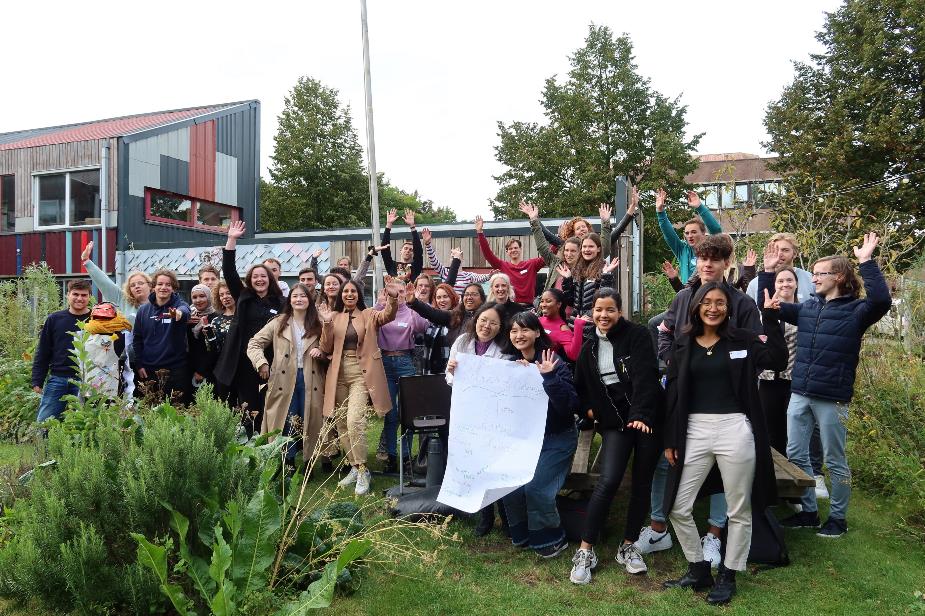New circular leaders are ready to go
20 November 2022
For the transition from a linear economy to a circular economy, we need good leadership. Reason enough for a special talent programme Leadership for the circular transition (Lct). Students from six universities of...

For the transition from a linear economy to a circular economy, we need good leadership. Reason enough for a special talent programme Leadership for the circular transition (Lct). Students from six universities of applied sciences worked on various sustainability issues over the past few months, while acquiring the necessary skills to deal with such complex issues. Project coordinators Bas van den Berg and Dianne de Fijter: ‘This first pilot of the programme has given us an appetite for more. Our goal is that soon every student in higher education will be working on transition issues.'
From accountancy, psychology and hospitality to business, applied physics and process & food technology, students who participated in the Lct programme came from all sorts of degree programmes. ‘That is exactly the kind of multidisciplinary approach we need in transition issues,’ explains Dianne. 'By looking at a situation from many different angles, you come up with creative solutions. For example, making menstrual products from discarded garments to tackle the problem of textile waste and menstrual poverty. This is just one of the ideas we encountered in the final presentation by students. The programme produced an avalanche of sustainable solutions!
Cultivating stamina
During the programme, students were challenged to think of promising circular business models. These are then presented to the Ministry of Infrastructure and Water Management, the programme's client. ‘We put students in contact with influential experts in the world of sustainability, so hopefully their ideas will actually come to fruition. But not before we have prepared them to hold their own in this world of sustainability,’ says Bas. He explains: ‘Transition issues take a long time to resolve and you can only solve a small piece of the puzzle. In the long run, this can make you burned-out or discouraged. Therefore, we consciously work on the necessary personal development skills in the programme. That is how we deliver professionals with the stamina to stay the course.’
Multiplying the impact
The programme is still extracurricular, but as far as Dianne and Bas are concerned, that is about to change. ‘We have now shown what the programme delivers: students help companies in the region with specific circular issues and they come up with solutions that can make a difference on a national level,’ says Dianne. “You also see that after the programme, students consciously choose a graduation internship in the direction of circularity and that their perseverance is trained. We want to multiply that impact by making the programme a regular part of the curriculum. In the second pilot project, we are going to talk to school boards to develop this.’
Staying relevant
Fully embedding circularity in education requires courage from the various degree programmes and lecturers, but it's a necessary step, according to Bas. ‘It touches on the very raison d'être of educational institutions. Nowadays, you can learn everything on the internet, without attending a regional training centre, university of applied sciences or research university. Educational institutions are increasingly being given the task of helping people become responsible adults. It's our responsibility to ensure that students can contribute something to society. If we want to remain relevant and continue to create value, we have to focus on these new forms of education.
The revenues
The Leadership for the circular transition programme is a collaboration between Het Groene Brein, Leren voor Morgen, RVO, the Ministry of Infrastructure and the Environment, the Mission Zero Centre of Expertise, The Hague University of Applied Sciences, Fontys University of Applied Sciences, Zuyd University of Applied Sciences, Rotterdam University of Applied Sciences, Amsterdam University of Applied Sciences and InHolland University of applied sciences. Students provided plans and tools to combat food waste, for example by educating consumers about product shelf life. The students also presented many solutions for circularity and sustainability in the garment industry. The winners of the sloth hackathon created a national label for sustainable clothing, that takes into account the sustainability of the production process, transportation and social factors.